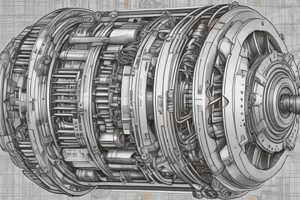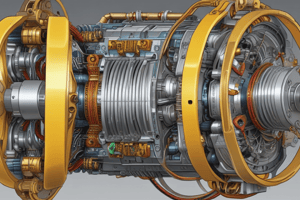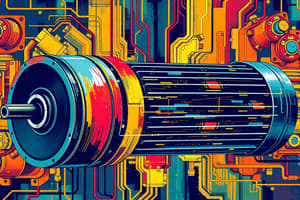Podcast
Questions and Answers
What is the relationship between torque and armature current in series motors before magnetic saturation?
What is the relationship between torque and armature current in series motors before magnetic saturation?
- Torque is proportional to the square of armature current. (correct)
- Torque decreases linearly with increased armature current.
- Torque remains constant regardless of armature current.
- Torque is inversely proportional to armature current.
Which characteristic curve is considered the electrical characteristic of a DC motor?
Which characteristic curve is considered the electrical characteristic of a DC motor?
- Armature current and field current characteristic
- Speed and armature current characteristic
- Torque and armature current characteristic (correct)
- Speed and torque characteristic
Why are series motors typically used for applications requiring high starting torque?
Why are series motors typically used for applications requiring high starting torque?
- They have a linear torque output at any current level.
- They rely on low armature currents for efficient operation.
- Torque is directly proportional to armature current in heavy loads. (correct)
- They maintain constant speed at all loads.
What happens to the speed of a series motor as the armature current increases?
What happens to the speed of a series motor as the armature current increases?
What type of characteristic curve is represented by the speed and torque relationship in DC motors?
What type of characteristic curve is represented by the speed and torque relationship in DC motors?
In series motors, what happens after the saturation point of the magnetic field is reached?
In series motors, what happens after the saturation point of the magnetic field is reached?
What does the N/Ia characteristic refer to in a DC motor?
What does the N/Ia characteristic refer to in a DC motor?
What is the consequence of low armature current in terms of speed for series motors?
What is the consequence of low armature current in terms of speed for series motors?
What is a primary application of compound-wound motors?
What is a primary application of compound-wound motors?
In differential-compound motors, what happens to the speed as the load increases?
In differential-compound motors, what happens to the speed as the load increases?
Which of the following characteristics of cumulatively compound DC motors is accurate?
Which of the following characteristics of cumulatively compound DC motors is accurate?
What is a major drawback of differential-compound motors?
What is a major drawback of differential-compound motors?
Which statement about DC motor starters is correct?
Which statement about DC motor starters is correct?
What effect does armature resistance have on the current drawn by the armature at startup?
What effect does armature resistance have on the current drawn by the armature at startup?
What type of motor is suitable for variable loads like electric shovels?
What type of motor is suitable for variable loads like electric shovels?
Which of the following machines would most likely use shunt DC motors?
Which of the following machines would most likely use shunt DC motors?
What is the purpose of the starting resistance in a DC motor circuit?
What is the purpose of the starting resistance in a DC motor circuit?
Where is the starting resistance connected in relation to the armature in a three-point shunt motor starter?
Where is the starting resistance connected in relation to the armature in a three-point shunt motor starter?
When does back electromotive force (back emf) begin to limit the current in a DC motor circuit?
When does back electromotive force (back emf) begin to limit the current in a DC motor circuit?
What happens when the lever reaches position 8 in the three-point shunt motor starter?
What happens when the lever reaches position 8 in the three-point shunt motor starter?
What role does the 'overcurrent release electromagnet' (OLRC) play in a DC motor starter?
What role does the 'overcurrent release electromagnet' (OLRC) play in a DC motor starter?
Why is the decrease in shunt field current negligible during the motor startup?
Why is the decrease in shunt field current negligible during the motor startup?
What condition causes the electromagnet NVRC to release the lever in the motor starter?
What condition causes the electromagnet NVRC to release the lever in the motor starter?
What is the initial configuration of the field winding when starting the DC motor?
What is the initial configuration of the field winding when starting the DC motor?
What could happen if a series motor is started without any mechanical load?
What could happen if a series motor is started without any mechanical load?
What is the relationship between speed and torque in a series motor?
What is the relationship between speed and torque in a series motor?
Why should a shunt motor not be started under heavy load?
Why should a shunt motor not be started under heavy load?
What characterizes a cumulatively compounded motor?
What characterizes a cumulatively compounded motor?
How does the speed of a shunt motor typically change under load?
How does the speed of a shunt motor typically change under load?
What distinguishes a differentially compounded motor from a cumulatively compounded motor?
What distinguishes a differentially compounded motor from a cumulatively compounded motor?
What effect does series excitation have on shunt excitation in cumulatively compounded motors?
What effect does series excitation have on shunt excitation in cumulatively compounded motors?
What is mainly indicated by the N/Ia characteristic of a shunt motor?
What is mainly indicated by the N/Ia characteristic of a shunt motor?
Flashcards
DC Motor Types
DC Motor Types
DC motors are categorized into shunt, series, and compound motors.
Torque-Armature Current (Ta/Ia) Characteristic
Torque-Armature Current (Ta/Ia) Characteristic
This characteristic shows the relationship between torque and armature current in a DC motor, essentially the motor's electrical behavior.
Speed-Armature Current (N/Ia) Characteristic
Speed-Armature Current (N/Ia) Characteristic
This characteristic links the motor's speed to its armature current, influencing motor selection for various applications.
Speed-Torque (N/Ta) Characteristic
Speed-Torque (N/Ta) Characteristic
Signup and view all the flashcards
Series Motor Torque Characteristic
Series Motor Torque Characteristic
Signup and view all the flashcards
Series Motor Speed Characteristic
Series Motor Speed Characteristic
Signup and view all the flashcards
Series Motor Applications
Series Motor Applications
Signup and view all the flashcards
Compound Wound Motors
Compound Wound Motors
Signup and view all the flashcards
Differential Compound Motor
Differential Compound Motor
Signup and view all the flashcards
Cumulative Compound Motor
Cumulative Compound Motor
Signup and view all the flashcards
DC Motor Starting Current
DC Motor Starting Current
Signup and view all the flashcards
DC Motor Starter
DC Motor Starter
Signup and view all the flashcards
Differential Compound Motor Application
Differential Compound Motor Application
Signup and view all the flashcards
Cumulative Compound Motor Application
Cumulative Compound Motor Application
Signup and view all the flashcards
Series DC Motor Application
Series DC Motor Application
Signup and view all the flashcards
Shunt DC Motor Application
Shunt DC Motor Application
Signup and view all the flashcards
DC Motor Starting
DC Motor Starting
Signup and view all the flashcards
Starting Resistance
Starting Resistance
Signup and view all the flashcards
Three-Point Starter
Three-Point Starter
Signup and view all the flashcards
Shunt Field Connection
Shunt Field Connection
Signup and view all the flashcards
Armature Resistance Reduction
Armature Resistance Reduction
Signup and view all the flashcards
Back EMF
Back EMF
Signup and view all the flashcards
Overload Protection
Overload Protection
Signup and view all the flashcards
No-Voltage Release Coil (NVRC)
No-Voltage Release Coil (NVRC)
Signup and view all the flashcards
Overload Release Coil (OLRC)
Overload Release Coil (OLRC)
Signup and view all the flashcards
Series Motor Starting
Series Motor Starting
Signup and view all the flashcards
Series Motor Torque
Series Motor Torque
Signup and view all the flashcards
Shunt Motor Starting
Shunt Motor Starting
Signup and view all the flashcards
Shunt Motor Speed
Shunt Motor Speed
Signup and view all the flashcards
Compound Motor
Compound Motor
Signup and view all the flashcards
Cumulative Compound Motor
Cumulative Compound Motor
Signup and view all the flashcards
Differential Compound Motor
Differential Compound Motor
Signup and view all the flashcards
Study Notes
Electrical Engine - Lecture 3
- Topic: DC Motors
- Outline:
- Characteristics of DC Motors
- Applications of DC Motors
- Starting of DC Motors
Characteristics of the DC Motor
- Types: Shunt motors, series motors, compound motors
- Judging Performance: Via motor characteristics (curves)
- Key Characteristics:
- Torque and Armature Current (Ta/Ia): Electrical characteristic; torque is proportional to the square of armature current (prior to saturation)
- Speed and Armature Current (N/Ia): Deciding factor for motor selection; speed varies inversely with armature current.
- Speed and Torque (N/Ta): Mechanical characteristic; speed is high when torque is low, and vice versa.
Characteristics of Series Motor
- Torque/Current (Ta/Ia): Initially, torque is proportional to the square of current (Ta∝Ia2). After saturation, torque is proportional to current (Ta∝Ia). Curve is parabolic.
- Shaft torque: Slightly lower than armature torque due to losses in the shaft.
- Speed/Current (N/Ia): Speed varies inversely with current, making it a variable-speed motor. Speed decreases with higher loads.
- Applications: Used in hoists, electric trains, and other applications requiring high starting torque.
Characteristics of Shunt Motors
- Torque/Current (Ta/Ia): Torque is directly proportional to current (Ta∝Ia). Curve is a straight line through the origin.
- Speed/Current (N/Ia): Speed is nearly constant, making it a constant-speed motor. Slight decrease in speed with increasing load due to flux weakening.
- Speed/Torque (N/Ta): Relationship derived from the previous two characteristics.
Characteristics of Compound Motors
- Types:
- Cumulative: Series and shunt fields aiding each other; high starting torque, reduced speed variations
- Differential: Series field opposing shunt field; unstable speed, not commonly used.
- Applications:
- Cumulative: Heavy loads with fluctuating demands (metal stamping, shovels)
- Differential: Less common; might be used in special experimental applications where precise starting control is needed.
Applications of DC Motors
- Shunt DC motors: Centrifugal pumps, lathes, blowers, drilling machines, milling machines, and machine tools.
- Series DC motors: Conveyors, hoists, elevators, cranes, and electric locomotives.
- Cumulative compound DC motors: Shears, heavy planers, rolling mills, and elevators
Starting of DC Motors
- Necessity: High starting current can cause damage to the motor, so a starter is needed to limit it.
- Principle: A starter (variable resistance) is connected in series with the armature to reduce the initial current. As the motor speed increases, the resistance is gradually removed.
- Three-Point Starter: Method of starting shunt motors. The field winding is directly connected and the armature winding is connected in series with several resistance steps. As the motor speed reaches the required speed, the resistance steps are gradually removed.
- Overload Protection: An overcurrent release mechanism to protect against overloading.
Studying That Suits You
Use AI to generate personalized quizzes and flashcards to suit your learning preferences.





